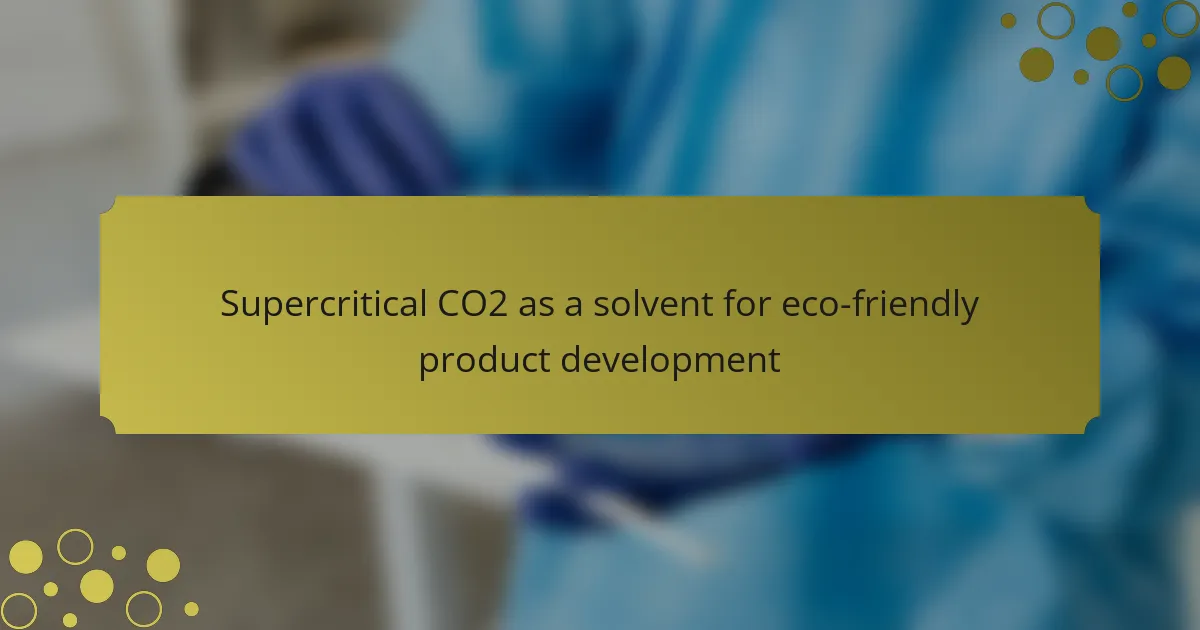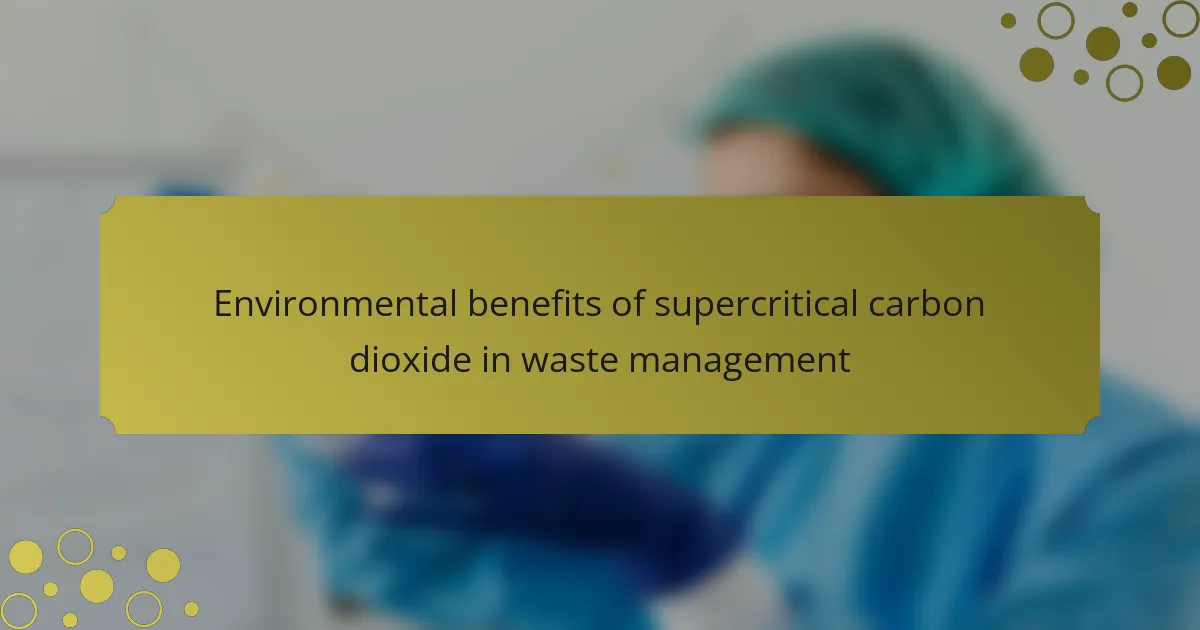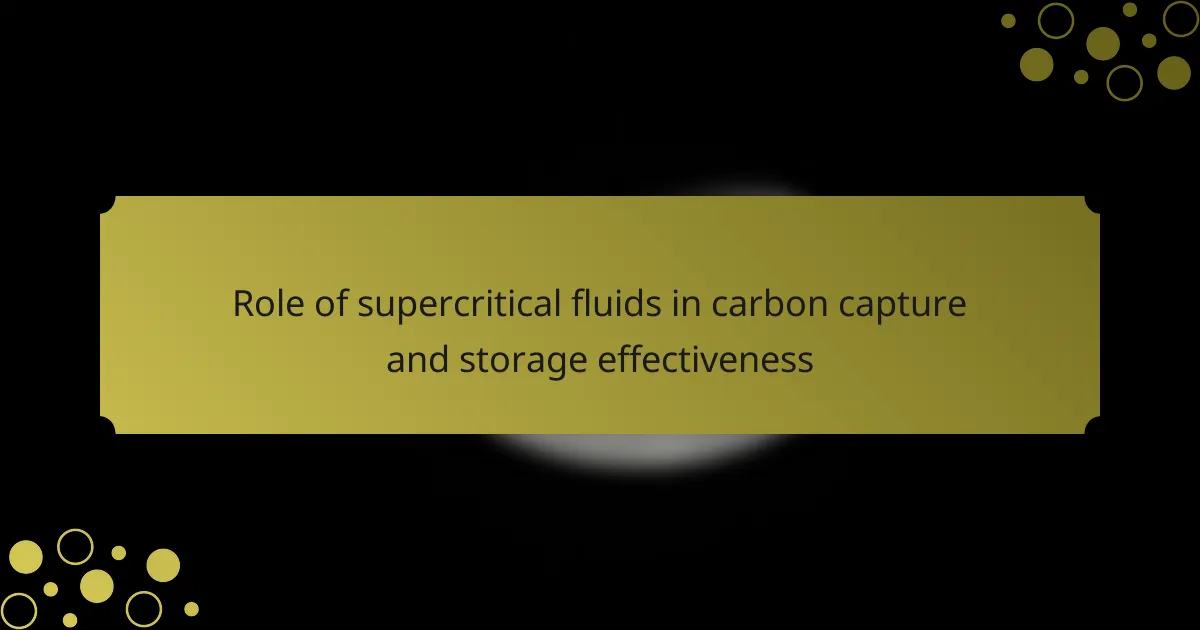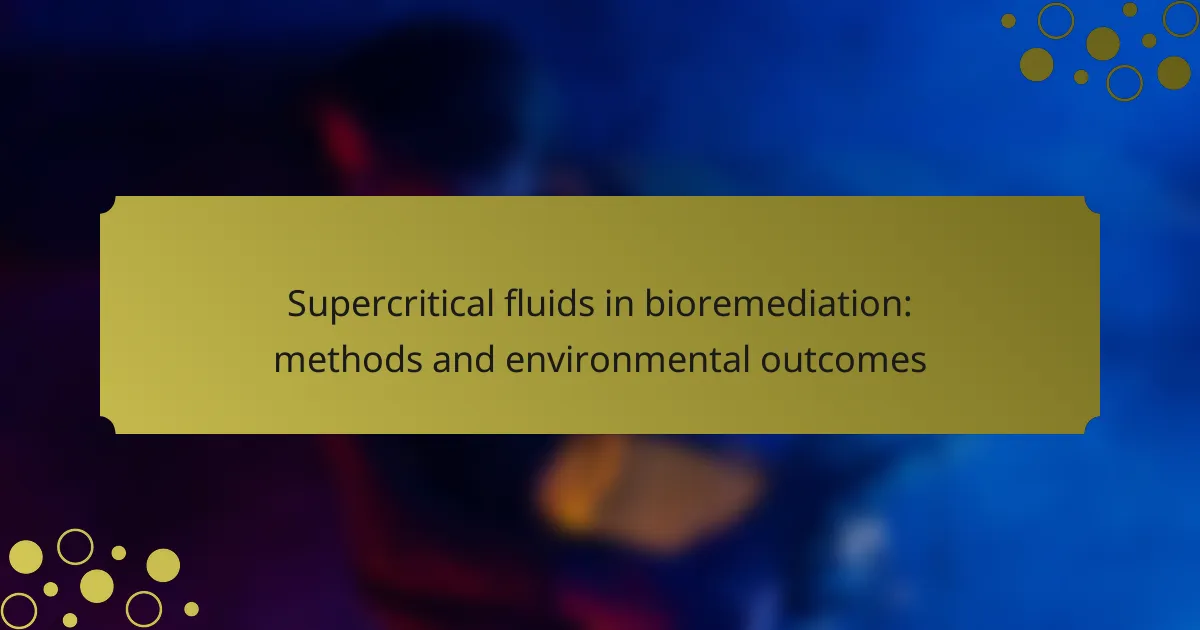Supercritical fluids are substances that exist above their critical temperature and pressure, exhibiting properties of both gases and liquids. This article explores the advantages of supercritical fluids in renewable energy production, highlighting their unique solvent capabilities that enhance chemical reactions and extraction processes. Key benefits include improved extraction efficiency, increased biofuel yields by up to 30%, and reduced energy consumption due to their ability to operate under mild conditions. The discussion also addresses the challenges associated with supercritical fluids, such as high operational costs, safety concerns, and scalability issues, providing a comprehensive overview of their role in advancing sustainable energy solutions.
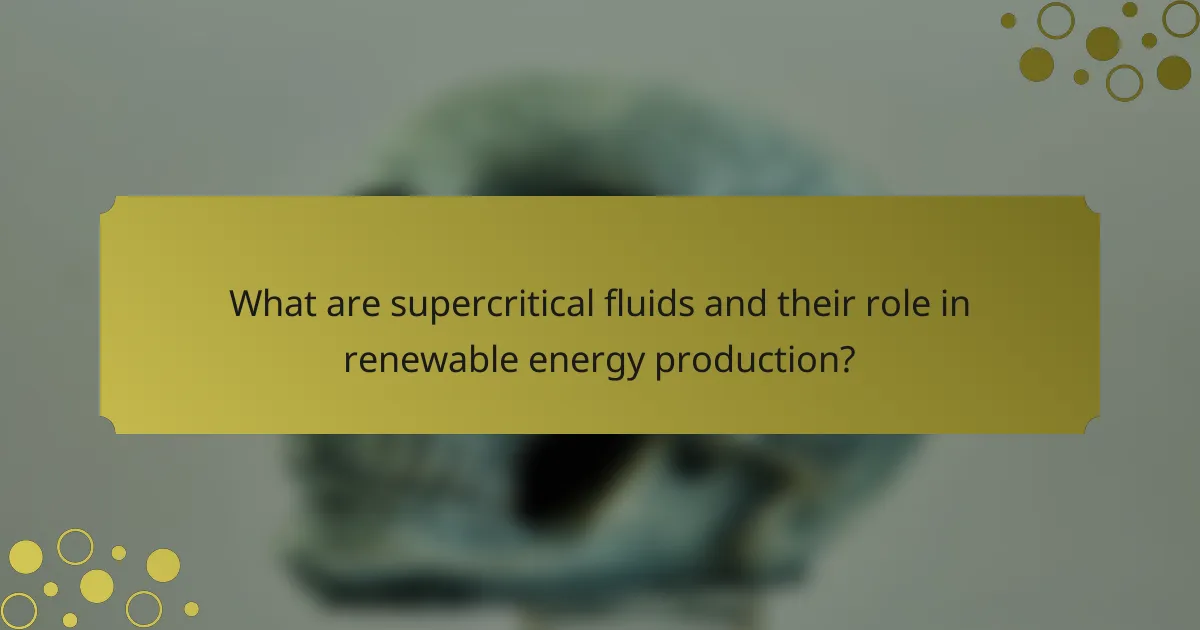
What are supercritical fluids and their role in renewable energy production?
Supercritical fluids are substances at a temperature and pressure above their critical point, exhibiting properties of both gases and liquids. They have unique solvent capabilities that enhance chemical reactions and extraction processes. In renewable energy production, supercritical fluids are utilized for efficient biomass conversion and extraction of biofuels. For example, supercritical carbon dioxide is used to extract essential oils and bioactive compounds from plant materials. This method reduces the need for harmful solvents and minimizes waste. Research indicates that using supercritical fluids can increase the yield of biofuels by up to 30% compared to traditional methods. Their ability to operate under mild conditions also lowers energy consumption, making renewable energy production more sustainable.
How do supercritical fluids differ from traditional solvents?
Supercritical fluids differ from traditional solvents primarily in their unique state. They exist at temperatures and pressures above their critical points, combining properties of both liquids and gases. This results in enhanced solvation capabilities compared to conventional solvents. Supercritical fluids can dissolve a wide range of compounds, including non-polar substances, which traditional solvents may struggle with.
For instance, supercritical carbon dioxide is commonly used in extraction processes due to its ability to selectively dissolve specific compounds. In contrast, traditional solvents often require additional processing steps to achieve similar results. Furthermore, supercritical fluids have lower viscosities, allowing for faster mass transfer rates. This characteristic improves efficiency in extraction and reaction processes.
Additionally, supercritical fluids are often non-toxic and environmentally friendly, unlike many traditional solvents that pose health and environmental risks. This makes them particularly advantageous in renewable energy applications, where sustainability is a priority.
What are the key properties of supercritical fluids?
Supercritical fluids have unique properties that distinguish them from conventional liquids and gases. They exhibit a combination of liquid and gas characteristics, allowing them to diffuse through solids like gases while dissolving materials like liquids. Supercritical fluids possess high density, which increases solvation power and mass transfer efficiency. They also have low viscosity, enabling easy flow and processing. Their tunable properties can be adjusted by changing temperature and pressure, leading to versatile applications. Supercritical fluids, such as supercritical carbon dioxide, are non-toxic and environmentally friendly, making them suitable for green technologies.
Why are these properties advantageous for energy production?
Supercritical fluids have unique properties that enhance energy production efficiency. Their high density increases solubility, allowing for better extraction of energy resources. This results in higher yields from biomass and other renewable sources. Additionally, supercritical fluids operate at lower temperatures compared to traditional methods. This reduces energy consumption and associated costs. Their ability to act as both solvent and reactant streamlines processes. Studies show that using supercritical fluids can improve thermal efficiency by up to 25%. This combination of factors makes supercritical fluids particularly advantageous for sustainable energy production.
What types of renewable energy processes utilize supercritical fluids?
Supercritical fluids are utilized in various renewable energy processes. These include biomass gasification, where supercritical water converts biomass into syngas. Supercritical carbon dioxide is used in enhanced geothermal systems for heat extraction. Additionally, supercritical fluids aid in the extraction of biofuels from algae. These processes benefit from the unique properties of supercritical fluids, such as increased solubility and reduced reaction times. This enhances efficiency and energy output in renewable energy applications.
How are supercritical fluids used in biomass conversion?
Supercritical fluids are used in biomass conversion to enhance the extraction of bioactive compounds and to facilitate chemical reactions. They operate at conditions above the critical temperature and pressure, making them effective solvents. This state allows for improved mass transfer and solubility of biomass components. For instance, supercritical water can convert biomass into biofuels through hydrothermal liquefaction. Research shows that this method can achieve high yields of bio-oil, with efficiencies exceeding 90%. Additionally, supercritical carbon dioxide is utilized for extracting oils and fats from biomass. This technique is environmentally friendly and avoids the use of harmful solvents.
What is the role of supercritical fluids in solar energy applications?
Supercritical fluids play a crucial role in solar energy applications by enhancing heat transfer and improving efficiency. They can operate at high temperatures and pressures, which allows them to absorb and transfer thermal energy effectively. In solar thermal systems, supercritical fluids can replace traditional heat transfer fluids. This replacement increases the thermal efficiency of energy conversion processes. Research indicates that using supercritical carbon dioxide (CO2) in concentrated solar power systems can achieve higher efficiency levels than conventional fluids. Studies have shown that supercritical CO2 can enhance the overall performance of solar energy systems by reducing heat losses and increasing energy output.
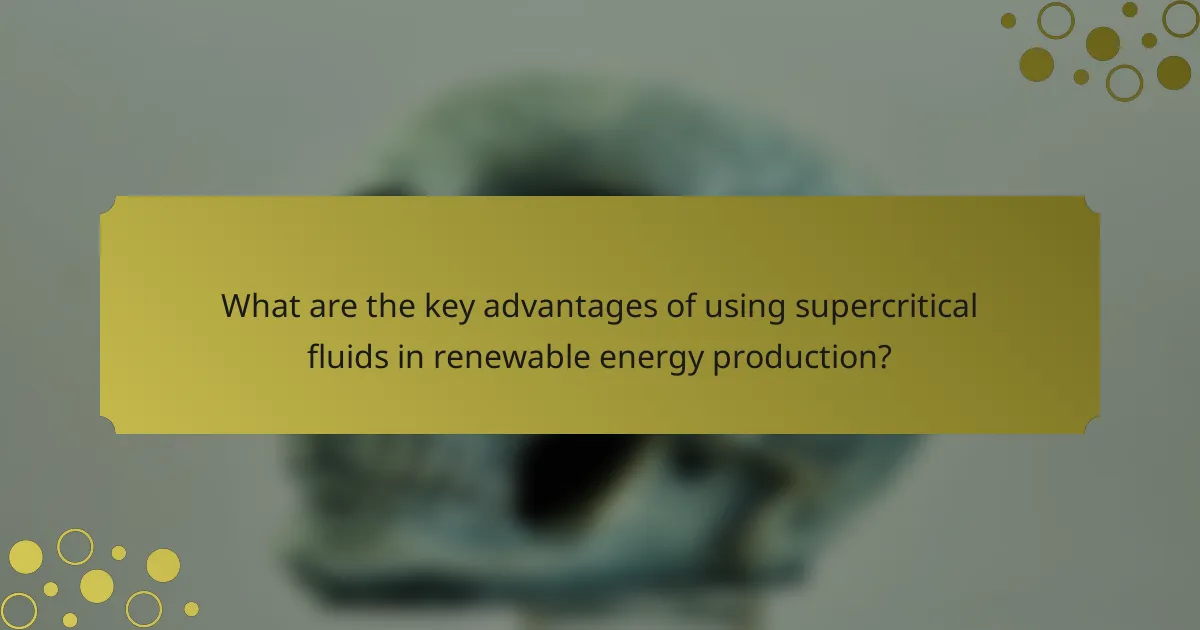
What are the key advantages of using supercritical fluids in renewable energy production?
Supercritical fluids offer several key advantages in renewable energy production. They provide enhanced extraction efficiency, allowing for better separation of valuable components from biomass. The high diffusivity of supercritical fluids improves mass transfer rates, resulting in faster processing times. Their tunable properties enable optimized solubility for various compounds, leading to higher yield. Additionally, supercritical fluids operate at lower temperatures compared to traditional methods, reducing energy consumption. This characteristic also minimizes thermal degradation of sensitive materials. Furthermore, the use of supercritical fluids often leads to fewer harmful byproducts, promoting a more sustainable process. These benefits position supercritical fluids as a valuable technology in advancing renewable energy solutions.
How do supercritical fluids enhance efficiency in energy systems?
Supercritical fluids enhance efficiency in energy systems by improving heat transfer and reducing energy losses. They possess unique properties, such as high density and low viscosity. These characteristics allow supercritical fluids to dissolve and transport energy more effectively. In power generation, they enable higher thermal efficiencies compared to traditional fluids. For example, supercritical carbon dioxide cycles can operate at elevated temperatures and pressures. This leads to increased energy output and reduced fuel consumption. Research indicates that using supercritical fluids can boost the efficiency of power plants by up to 20%. This improvement contributes to lower greenhouse gas emissions and more sustainable energy production.
What impact do they have on reaction rates and yields?
Supercritical fluids significantly enhance reaction rates and yields in chemical processes. Their unique properties, such as low viscosity and high diffusivity, facilitate faster molecular interactions. This leads to more efficient reactant mixing and improved mass transfer. Studies show that reactions in supercritical fluids can proceed at rates several times faster than in conventional solvents. For example, supercritical carbon dioxide has been found to increase yield percentages in biodiesel production by up to 30%. The ability to maintain high pressure and temperature in supercritical conditions also helps to drive reactions towards completion, maximizing product yields.
How do supercritical fluids reduce waste and emissions?
Supercritical fluids reduce waste and emissions by enhancing extraction processes and promoting cleaner chemical reactions. They facilitate the separation of valuable compounds from biomass with minimal solvent use. This results in less waste generation compared to traditional methods. Supercritical fluids operate at high pressure and temperature, allowing for efficient breakdown of materials. This efficiency leads to lower energy consumption and reduced greenhouse gas emissions. Studies show that using supercritical carbon dioxide for extraction can cut solvent waste by up to 90%. Additionally, the non-toxic nature of supercritical fluids minimizes environmental impact.
What economic benefits do supercritical fluids provide in renewable energy?
Supercritical fluids provide significant economic benefits in renewable energy by enhancing extraction efficiency and reducing operational costs. Their unique properties allow for higher solubility of materials, leading to improved yield in biofuel production. This efficiency reduces the amount of raw materials needed, lowering overall expenses. Additionally, supercritical fluids operate at lower temperatures and pressures, which minimizes energy consumption during processing. Research shows that using supercritical CO2 for extraction can yield up to 30% more bioactive compounds compared to traditional methods. Furthermore, the reduction in solvent usage leads to lower waste disposal costs and environmental compliance expenses. Overall, these factors contribute to a more cost-effective and sustainable renewable energy production process.
How can they lower production costs?
They can lower production costs by optimizing the use of supercritical fluids. Supercritical fluids enhance extraction efficiency, reducing the amount of raw materials needed. This process minimizes energy consumption compared to traditional methods. Additionally, supercritical fluids operate at lower temperatures and pressures, which decreases operational costs. Research indicates that using supercritical CO2 for extraction can lower costs by up to 30% in certain applications. This efficiency leads to higher yield rates, further driving down costs. Overall, the adoption of supercritical fluids in renewable energy production streamlines processes and reduces waste.
What are the long-term financial implications for energy producers?
Long-term financial implications for energy producers include increased operational efficiency and reduced costs. Supercritical fluids enhance energy conversion processes. This technology can lower fuel consumption and emissions. Consequently, producers may see higher profit margins over time. Research indicates that transitioning to supercritical systems can yield savings of up to 20% in fuel costs. Additionally, energy producers may benefit from government incentives for adopting cleaner technologies. These factors collectively contribute to a more sustainable financial outlook for energy producers.
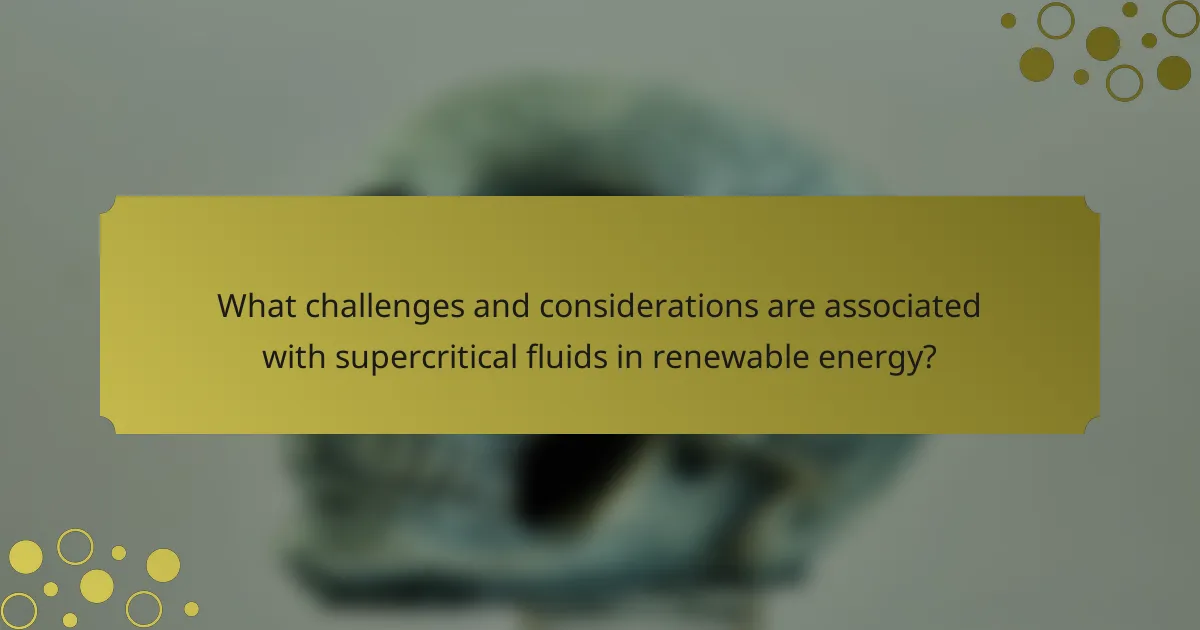
What challenges and considerations are associated with supercritical fluids in renewable energy?
Supercritical fluids in renewable energy face several challenges and considerations. These include high operational costs due to the need for specialized equipment. The requirement for precise temperature and pressure control complicates system design. Safety concerns arise from the properties of supercritical fluids, which can be hazardous under certain conditions. Material compatibility is another issue, as some materials may degrade in supercritical environments. Additionally, the scalability of supercritical fluid technologies remains a significant challenge. Finally, regulatory hurdles can impede the deployment of supercritical fluid systems in renewable energy applications.
What are the technical challenges in implementing supercritical fluid systems?
The technical challenges in implementing supercritical fluid systems include high pressure requirements, material compatibility, and process control. Supercritical fluids operate at pressures above 22.1 MPa, necessitating robust equipment. Many materials may degrade or fail under these conditions, limiting options for construction. Additionally, precise control of temperature and pressure is critical for maintaining the supercritical state. Fluctuations can lead to inefficiencies or system failure. Scale-up from laboratory to industrial applications poses further difficulties. The complexity of integrating supercritical systems with existing infrastructure also presents challenges. Research indicates that these factors can hinder widespread adoption and optimization of supercritical fluid technologies in renewable energy applications.
How does equipment design affect the use of supercritical fluids?
Equipment design significantly influences the efficiency and effectiveness of supercritical fluids. Proper design ensures optimal pressure and temperature conditions for supercritical fluid applications. Equipment must withstand high pressures, typically exceeding 3000 psi, which is crucial for maintaining the supercritical state. Additionally, materials used in construction must resist corrosion from supercritical solvents. The design also impacts flow rates and mixing, which are vital for maximizing extraction and reaction rates. For instance, specific geometries can enhance mass transfer, improving the overall process efficiency. Studies show that well-designed equipment can increase yield by up to 50% in extraction processes. Hence, equipment design is critical for harnessing the full potential of supercritical fluids in renewable energy production.
What safety concerns must be addressed?
Safety concerns in supercritical fluid applications include high-pressure risks, chemical toxicity, and thermal hazards. High-pressure systems can lead to equipment failure or leaks. Toxic substances may pose health risks during processing. Thermal hazards arise from elevated temperatures in supercritical fluid processes. Proper safety protocols and equipment are essential to mitigate these risks. Regular maintenance and monitoring can prevent accidents. Training for personnel is crucial to ensure safe operations. Adhering to industry regulations enhances safety measures in these applications.
What are the future prospects for supercritical fluids in renewable energy?
Supercritical fluids have significant future prospects in renewable energy. They can enhance energy efficiency in biomass conversion processes. Supercritical fluids enable better extraction of biofuels from organic materials. They also facilitate improved heat transfer in energy systems. Research indicates that supercritical CO2 cycles may outperform traditional thermal cycles. This can lead to higher efficiency in power generation. The integration of supercritical fluids in solar thermal systems is gaining attention. These applications can potentially reduce costs and emissions in renewable energy production.
How is research advancing the use of supercritical fluids?
Research is advancing the use of supercritical fluids by exploring their applications in renewable energy production. Recent studies focus on enhancing extraction processes for biofuels. For instance, supercritical CO2 is being utilized to extract essential oils and lipids from biomass. This method increases yield and efficiency compared to traditional extraction techniques. Additionally, researchers are investigating the use of supercritical fluids in carbon capture and storage. The ability to dissolve gases at high pressures allows for improved sequestration methods. Studies have shown that supercritical fluids can reduce energy consumption in various processes. Overall, ongoing research is expanding the potential of supercritical fluids in sustainable energy solutions.
What innovations are on the horizon for this technology?
Innovations on the horizon for supercritical fluid technology in renewable energy production include enhanced extraction methods and improved efficiency. Researchers are developing advanced supercritical fluid extraction techniques that can maximize yield while minimizing energy consumption. Innovations in reactor design are expected to increase the scalability of these processes. Additionally, integration with other renewable technologies, such as solar and wind, is being explored to optimize energy output. The use of novel solvents in supercritical processes may lead to more sustainable practices. Recent studies indicate that these advancements could significantly lower operational costs and improve overall energy conversion rates.
What best practices should be followed when using supercritical fluids in renewable energy production?
Best practices for using supercritical fluids in renewable energy production include maintaining optimal temperature and pressure conditions. This ensures efficient extraction and conversion processes. Regular monitoring of fluid properties is crucial for performance consistency. Implementing proper safety protocols mitigates risks associated with high-pressure systems. Utilizing corrosion-resistant materials enhances equipment longevity. Employing advanced separation techniques improves product purity and yield. Continuous research and development are vital for optimizing processes and discovering new applications. These practices are supported by studies demonstrating increased efficiency and sustainability in energy production.
Supercritical fluids are substances that exist at temperatures and pressures above their critical points, exhibiting unique properties that make them advantageous in renewable energy production. This article explores the role of supercritical fluids in enhancing biomass conversion, improving extraction efficiency, and reducing energy consumption in energy systems. Key benefits include higher yields of biofuels, lower operational costs, and a more sustainable approach to energy production. Additionally, the article addresses the challenges and considerations associated with implementing supercritical fluid technologies, as well as future prospects and best practices for their use in renewable energy applications.
